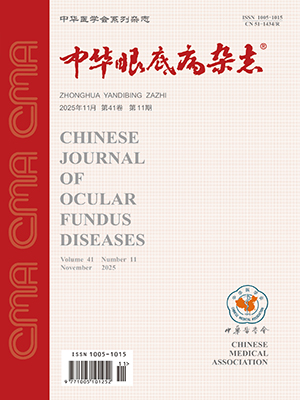| 1. |
Eckardt C, Paulo EB. Heads-up surgery for vitreoretinal procedures: an experimental and clinical study[J]. Retina, 2016, 36(1): 137-147. DOI: 10.1097/IAE.0000000000000689.
|
| 2. |
Seider MI, Carrasco-Zevallos OM, Gunther R, et al. Real-time volumetric imaging of vitreoretinal surgery with a prototype microscope-integrated swept-source OCT device[J]. Ophthalmol Retina, 2018, 2(5): 401-410. DOI: 10.1016/j.oret.2017.08.023.
|
| 3. |
Zhang T, Tang W, Xu G. Comparative analysis of three-dimensional heads-up vitrectomy and traditional microscopic vitrectomy for vitreoretinal diseases[J]. Curr Eye Res, 2019, 44(10): 1080-1086. DOI: 10.1080/02713683.2019.1612443.
|
| 4. |
Talcott KE, Adam MK, Sioufi K, et al. Comparison of a three-dimensional heads-up display surgical platform with a standard operating microscope for macular surgery[J]. Ophthalmol Retina, 2019, 3(3): 244-251. DOI: 10.1016/j.oret.2018.10.016.
|
| 5. |
Iwata A, Kusaka S, Ishimaru M, et al. Early vitrectomy to reverse macular dragging in a one-month-old boy with familial exudative vitreoretinopathy[J/OL]. Am J Ophthalmol Case Rep, 2019, 15: 100493[2019-06-11]. https://linkinghub.elsevier.com/retrieve/pii/S2451-9936(18)30406-7. DOI: 10.1016/j.ajoc.2019.100493.
|
| 6. |
Rejdak R, Nowakowska D, Wrona K, et al. Outcomes of vitrectomy in pediatric retinal detachment with proliferative vitreoretinopathy[J/OL]. J Ophthalmol, 2017, 2017: 8109390[2017-08-03]. https://doi.org/10.1155/2017/8109390. DOI: 10.1155/2017/8109390.
|
| 7. |
Chuang CC, Chen SN. Induction of posterior vitreous detachment in pediatric vitrectomy by preoperative intravitreal injection of tissue plasminogen activator[J]. J Pediatr Ophthalmol Strabismus, 2016, 53(2): 113-118. DOI: 10.3928/01913913-20160209-01.
|
| 8. |
Hocaoglu M, Karacorlu M, Sayman Muslubas I, et al. Anatomical and functional outcomes following vitrectomy for advanced familial exudative vitreoretinopathy: a single surgeon's experience[J]. Br J Ophthalmol, 2017, 101(7): 946-950. DOI: 10.1136/bjophthalmol-2016-309526.
|
| 9. |
Lim JI, Machen L, Arteaga A, et al. Comparison of visual and anatomical outcomes of eyes undergoing type Ⅰ boston keratoprosthesis with combination pars plana vitrectomy with eyes without combination vitrectomy[J]. Retina, 2018, 38 Suppl 1: S125-133. DOI: 10.1097/IAE.0000000000002036.
|
| 10. |
Rossi T, Caporossi T, Rizzo S, et al. Autologous internal limiting membrane flap for retinal detachment due to posterior retinal tears over choroidal atrophy in highly myopic eyes[J]. Br J Ophthalmol, 2019, 103(8): 1133-1136. DOI: 10.1136/bjophthalmol-2018-313099.
|
| 11. |
Browning DJ. Vitrectomy for proliferative diabetic retinopathy: does anyone know the complication rate?[J]. JAMA Ophthalmol, 2016, 134(1): 86-87. DOI: 10.1001/jamaophthalmol.2015.4597.
|
| 12. |
Lin CJ, Peng KL. Intraoperative severe suprachoroidal air as a complication of 23-gauge vitrectomy combined with air-fluid exchange[J]. Int Med Case Rep J, 2018, 11: 173-176. DOI: 10.2147/IMCRJ.S163085.
|
| 13. |
Iwahashi-Shima C, Miki A, Hamasaki T, et al. Intraocular pressure elevation is a delayed-onset complication after successful vitrectomy for stages 4 and 5 retinopathy of prematurity[J]. Retina, 2012, 32(8): 1636-1642. DOI: 10.1097/IAE.0b013e3182551c54.
|
| 14. |
Wensheng L, Wu R, Wang X, et al. Clinical complications of combined phacoemulsification and vitrectomy for eyes with coexisting cataract and vitreoretinal diseases[J]. Eur J Ophthalmol, 2009, 19(1): 37-45. DOI: 10.1177/112067210901900106.
|
| 15. |
Shinkai Y, Oshima Y, Yoneda K, et al. Multicenter survey of sutureless 27-gauge vitrectomy for primary rhegmatogenous retinal detachment: a consecutive series of 410 cases[J]. Graefe's Arch Clin Exp Ophthalmol, 2019, 257(12): 2591-2600. DOI: 10.1007/s00417-019-04448-2.
|
| 16. |
Coppola M, La Spina C, Rabiolo A, et al. Heads-up 3D vision system for retinal detachment surgery[J]. Int J Retina Vitreous, 2017, 3: 46. DOI: 10.1186/s40942-017-0099-2.
|
| 17. |
Zhang Z, Wang L, Wei Y, et al. The preliminary experiences with three-dimensional heads-up display viewing system for vitreoretinal surgery under various status[J]. Curr Eye Res, 2019, 44(1): 102-109. DOI: 10.1080/02713683.2018.1526305.
|
| 18. |
Ehlers JP, Uchida A, Srivastava SK. The integrative surgical theater: combining intraoperative optical coherence tomography and 3D digital visualization for vitreoretinal surgery in the DISCOVER Study[J]. Retina, 2018, 38 Suppl 1: S88-96. DOI: 10.1097/IAE.0000000000001999.
|
| 19. |
Dutra-Medeiros M, Nascimento J, Henriques J, et al. Three-dimensional head-mounted display system for ophthalmic surgical procedures[J]. Retina, 2017, 37(7): 1411-1414. DOI: 10.1097/IAE.0000000000001514.
|
| 20. |
Chhaya N, Helmy O, Piri N, et al. Comparison of 2D and 3D video displays for teaching vitreoretinal surgery[J]. Retina, 2018, 38(8): 1556-1561. DOI: 10.1097/IAE.0000000000001743.
|
| 21. |
Rizzo S, Abbruzzese G, Savastano A, et al. 3D surgical viewing system in ophthalmology: perceptions of the surgical team[J]. Retina, 2018, 38(4): 857-861. DOI: 10.1097/IAE.0000000000002018.
|
| 22. |
Read SP, Fortun JA. Visualization of the retina and vitreous during vitreoretinal surgery: new technologies[J]. Curr Opin Ophthalmol, 2017, 28(3): 238-241. DOI: 10.1097/ICU.0000000000000368.
|




